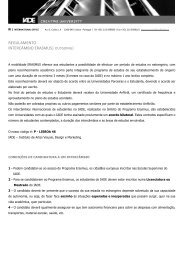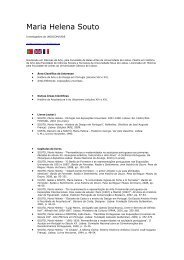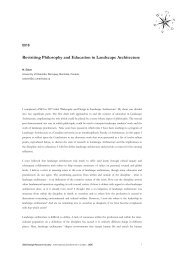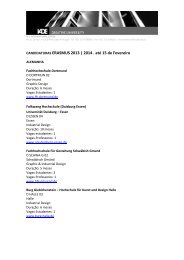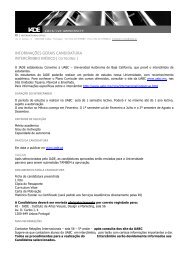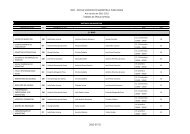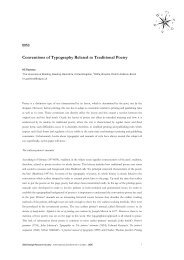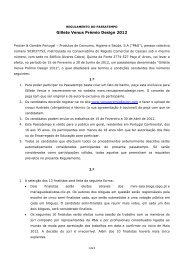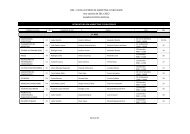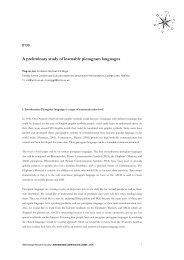The Discrete and the Continuous in Architecture and Design - IADE
The Discrete and the Continuous in Architecture and Design - IADE
The Discrete and the Continuous in Architecture and Design - IADE
You also want an ePaper? Increase the reach of your titles
YUMPU automatically turns print PDFs into web optimized ePapers that Google loves.
0039<br />
<strong>The</strong> <strong>Discrete</strong> <strong>and</strong> <strong>the</strong> <strong>Cont<strong>in</strong>uous</strong> <strong>in</strong> <strong>Architecture</strong> <strong>and</strong> <strong>Design</strong><br />
L Feast<br />
Victoria University of Well<strong>in</strong>gton, Well<strong>in</strong>gton, New Zeal<strong>and</strong><br />
lukefeast@gmail.com<br />
Fold<strong>in</strong>g <strong>in</strong> <strong>Architecture</strong> <strong>and</strong> <strong>the</strong> Ecology of Susta<strong>in</strong>able <strong>Design</strong><br />
<strong>The</strong> notion of <strong>the</strong> environment as a cont<strong>in</strong>uous network of <strong>in</strong>teract<strong>in</strong>g flows of <strong>in</strong>formation,<br />
artefacts <strong>and</strong> subjects, as characterised by Ezio Manz<strong>in</strong>i’s ecological model of design <strong>and</strong> Greg Lynn’s folded<br />
concept of architecture, has prompted <strong>the</strong> development of a variety of <strong>in</strong>novative techniques that can engage<br />
time, change, mobile po<strong>in</strong>ts of view, <strong>and</strong> which can reorganise multiple economies, ecologies, <strong>in</strong>formation<br />
systems, <strong>and</strong> social groups. <strong>The</strong>se techniques such as scenario build<strong>in</strong>g <strong>in</strong> design <strong>and</strong> diagramm<strong>in</strong>g <strong>in</strong><br />
architecture, while attached to two dist<strong>in</strong>ct traditions do <strong>in</strong>volve a productive overlap of concerns <strong>and</strong><br />
concepts which can provide useful exchange <strong>and</strong> dialogue <strong>in</strong> <strong>the</strong> <strong>in</strong>vestigation of mutual problems of<br />
representation, practice, <strong>and</strong> <strong>the</strong> relationship of ethics <strong>and</strong> aes<strong>the</strong>tics <strong>in</strong> architecture <strong>and</strong> design.<br />
In architecture, this <strong>in</strong>creas<strong>in</strong>g <strong>in</strong>fluence of a dynamic model of complexity has characterised <strong>the</strong><br />
displacement of deconstructivist techniques of collage <strong>and</strong> contradiction established <strong>in</strong> <strong>the</strong> 1980’s with a folded<br />
logic of cont<strong>in</strong>uity <strong>and</strong> curvature <strong>in</strong> <strong>the</strong> 1990’s. A parallel transition can be discerned <strong>in</strong> design with<strong>in</strong> <strong>the</strong><br />
transition from <strong>the</strong> external moral code of green design to <strong>the</strong> immanent ethics of susta<strong>in</strong>able design. <strong>The</strong><br />
implications <strong>and</strong> <strong>in</strong>terrelations between <strong>the</strong> emergence of fold<strong>in</strong>g <strong>in</strong> architecture <strong>and</strong> of ecologically susta<strong>in</strong>able<br />
design can be productively <strong>in</strong>vestigated through <strong>the</strong>ir <strong>in</strong>teractive reflection with <strong>the</strong> dist<strong>in</strong>ction made between<br />
discrete multiplicities <strong>and</strong> cont<strong>in</strong>uous multiplicities as developed by <strong>the</strong> philosopher Gilles Deleuze (1925-<br />
1995). This dist<strong>in</strong>ction <strong>in</strong> models of complexity can be <strong>in</strong>troduced as a difference between a metric space that<br />
can be reduced to an aggregate of po<strong>in</strong>ts, <strong>and</strong> a non-metric cont<strong>in</strong>uum that can only be qualitatively<br />
differentiated <strong>in</strong> time.<br />
Table 1<br />
2006 <strong>Design</strong> Research Society . International Conference <strong>in</strong> Lisbon . <strong>IADE</strong> 1
Transitions toward <strong>Cont<strong>in</strong>uous</strong> Models of Complexity <strong>in</strong> <strong>Architecture</strong> <strong>and</strong> <strong>Design</strong><br />
Folded architecture<br />
Logic of cont<strong>in</strong>uity<br />
2000 <strong>and</strong> curvature 2000<br />
Ecologically<br />
susta<strong>in</strong>able design<br />
Ethics immanent to<br />
design<br />
1990 Deconstructivist 1990<br />
<strong>Architecture</strong><br />
1980<br />
Techniques of collage<br />
<strong>and</strong> contradiction 1980<br />
Green design<br />
External moral code<br />
From Deconstructivism to Fold<strong>in</strong>g <strong>in</strong> <strong>Architecture</strong>.<br />
In <strong>the</strong> key architectural text of this period, <strong>the</strong> 1993 issue of Architectural design entitled Fold<strong>in</strong>g <strong>in</strong><br />
architecture, Deleuze’s philosophical concepts were employed by a number of <strong>the</strong>orists <strong>and</strong> architects <strong>in</strong> <strong>the</strong><br />
development of a new logic of curval<strong>in</strong>earity. This logic sought to displace <strong>the</strong> fragmentary collage of opposition<br />
<strong>and</strong> contradiction characteristic of <strong>the</strong> angular forms of deconstructivist architecture, through <strong>the</strong> <strong>in</strong>tegration<br />
of difference <strong>in</strong> <strong>the</strong> calculus of cont<strong>in</strong>uous variation <strong>in</strong>herent <strong>in</strong> curved <strong>and</strong> flexible forms; <strong>the</strong> production of<br />
which was becom<strong>in</strong>g <strong>in</strong>creas<strong>in</strong>gly accessible <strong>in</strong> conjunction with developments <strong>in</strong> computer modell<strong>in</strong>g<br />
technology. Accord<strong>in</strong>g to Greg Lynn, <strong>the</strong> editor of Fold<strong>in</strong>g <strong>in</strong> architecture, Deleuze’s concept of <strong>the</strong> fold is of<br />
particular importance for this <strong>in</strong>vestigation of <strong>the</strong> “<strong>in</strong>tegration of differences with<strong>in</strong> a cont<strong>in</strong>uous yet<br />
heterogeneous system” for it provides “a <strong>the</strong>ory of syn<strong>the</strong>sis <strong>and</strong> unity that ma<strong>in</strong>ta<strong>in</strong>s detail as a discrete<br />
moment that participates <strong>in</strong>tensively <strong>in</strong> <strong>the</strong> construction of a new k<strong>in</strong>d of whole” (Lynn, 2004/1993, p. 11, 24).<br />
Fold<strong>in</strong>g implies a smooth relationship between diverse elements that unlike a simple hierarchy or<br />
modularity, weaves toge<strong>the</strong>r a multiplicity of macro <strong>and</strong> micro scales whose consistency is nei<strong>the</strong>r exterior nor<br />
super-structural but which is characterised <strong>in</strong> Deleuze’s terms by “immanence of field without transcendent<br />
unification, cont<strong>in</strong>uity of l<strong>in</strong>e without global centralisation <strong>and</strong> contiguity of parts without dist<strong>in</strong>ct totalization”<br />
(Deleuze, 1988/1986, p. 27). Accord<strong>in</strong>g to architectural <strong>the</strong>orist John Rajchman (2004/1993, p. 78) <strong>in</strong> his essay<br />
Out of <strong>the</strong> Fold from Fold<strong>in</strong>g <strong>in</strong> architecture, Deleuze’s concept of <strong>the</strong> fold offers an orig<strong>in</strong>al concept of<br />
complexity that does not consist <strong>in</strong> <strong>the</strong> one that is said <strong>in</strong> many ways, but ra<strong>the</strong>r <strong>in</strong> <strong>the</strong> fact each th<strong>in</strong>g may<br />
always diverge <strong>in</strong>to many o<strong>the</strong>rs, as <strong>in</strong> <strong>the</strong> ever fork<strong>in</strong>g paths <strong>in</strong> Borges’ fabled garden; a k<strong>in</strong>d of complexity<br />
whose fabric can never be completely unfolded or def<strong>in</strong>itely explicated, s<strong>in</strong>ce to unfold or explicate it is only to<br />
fold or complicate it anew. Thus <strong>the</strong> fold is a model of complexity that does not consist of fragments or ru<strong>in</strong>s<br />
of a lost or absent whole, but <strong>in</strong> <strong>the</strong> potential for divergence with any given unity. In this manner accord<strong>in</strong>g to<br />
Rajchman,<br />
<strong>the</strong> concept of complexity is freed from <strong>the</strong> logic of contradiction or opposition <strong>and</strong> connected<br />
<strong>in</strong>stead to a logic of <strong>in</strong>tervals: it becomes a matter of a ‘free’ differentiation (not subord<strong>in</strong>ated to<br />
2006 <strong>Design</strong> Research Society . International Conference <strong>in</strong> Lisbon . <strong>IADE</strong> 2
fixed analogies or categorical identities) <strong>and</strong> a ‘complex’ repetition (not restricted to <strong>the</strong> imitation of<br />
a pre-given model, orig<strong>in</strong> or end). (Rajchman, 2004/1993, p. 78)<br />
<strong>The</strong> flexible complexity generated by folded architecture is a notion of complexity <strong>in</strong> divergence that can<br />
be considered as organic or “biomorphic” <strong>and</strong> <strong>in</strong>deed characterised as “ecological” (Hays, Ingraham &<br />
Kennedy, 1995, p. 9). This ecological model of complexity has also been articulated <strong>in</strong> design by a number of<br />
authors (Buchanan 2000, 2001; Krippendorf, 1995/1989; Manz<strong>in</strong>i 1995/1992) through <strong>the</strong> concept of <strong>the</strong><br />
ecology of <strong>the</strong> artificial.<br />
From Green <strong>Design</strong> to Ecologically Susta<strong>in</strong>able <strong>Design</strong><br />
S<strong>in</strong>ce <strong>the</strong> 1960’s <strong>and</strong> 1970’s, <strong>the</strong> ecological concept of <strong>the</strong> complexity of our world has seen ethical<br />
concerns <strong>in</strong> design become <strong>in</strong>creas<strong>in</strong>gly centred on <strong>the</strong> impact of products as part of <strong>the</strong> physical <strong>and</strong> social<br />
environment ra<strong>the</strong>r than focused on <strong>the</strong> personal morality of <strong>the</strong> designer or on social conditions of<br />
production (Whitely, 1999, pp. 196-200). Borrowed from <strong>the</strong> environmental movement <strong>in</strong> politics, <strong>the</strong> term<br />
green quickly became <strong>the</strong> buzz word <strong>in</strong> design culture through <strong>the</strong> 1980’s with a proliferation of “how to be<br />
green” design exhibitions <strong>and</strong> design literature. As suggested by Paul<strong>in</strong>e Madge (1997, p. 46), green design<br />
varied from dark green to pale green, “between those who advocated a radical rejection of <strong>the</strong> status quo, a<br />
critique of <strong>the</strong> paradigm of modern <strong>in</strong>dustrial society (whe<strong>the</strong>r capitalist or socialist), <strong>and</strong> <strong>the</strong> lighter green idea<br />
of modify<strong>in</strong>g exist<strong>in</strong>g <strong>in</strong>stitutions <strong>and</strong> practices.”<br />
<strong>The</strong> broaden<strong>in</strong>g of <strong>the</strong> concerns of designers from simply add<strong>in</strong>g environmental criteria <strong>in</strong>to exist<strong>in</strong>g<br />
design processes, to critically reconsider<strong>in</strong>g design <strong>and</strong> <strong>in</strong>dustrial practice, follows a transition <strong>in</strong> <strong>the</strong> 1980’s <strong>and</strong><br />
<strong>the</strong> early 1990’s from pale green design to <strong>the</strong> darker green of ecologically susta<strong>in</strong>able design. For example, as<br />
proposed Anne-Marie Willis at <strong>the</strong> <strong>in</strong>ternational Eco<strong>Design</strong> Conference held at RMIT <strong>in</strong> 1991, “ecodesign has<br />
<strong>the</strong> potential to be more than <strong>the</strong> reform of exist<strong>in</strong>g design, for if taken seriously, it can establish a new<br />
foundation for design that could br<strong>in</strong>g economic <strong>and</strong> ecological need <strong>in</strong>to a new union” (Quoted <strong>in</strong> Madge,<br />
1997, p. 50).<br />
This possibility for an ecological view to provide a ground for design ethics that is immanent to<br />
design ra<strong>the</strong>r than <strong>in</strong> <strong>the</strong> form of a moral code, is supported by Ala<strong>in</strong> F<strong>in</strong>deli <strong>in</strong> his 1994 paper Ethics, Aes<strong>the</strong>tics<br />
<strong>and</strong> <strong>Design</strong>. F<strong>in</strong>deli (1994, p. 52) argues that <strong>the</strong> cartographic mapp<strong>in</strong>g <strong>the</strong> world of artefacts <strong>in</strong> a topological<br />
plane which “represents <strong>the</strong> world of artefacts as a cont<strong>in</strong>uous space, [suggests] <strong>the</strong> possibility of describ<strong>in</strong>g it<br />
by <strong>the</strong> means of a unified <strong>the</strong>ory.” For F<strong>in</strong>deli (1994, p. 66, 67) this notion of a cont<strong>in</strong>uous topological model<br />
enables us “to envision cont<strong>in</strong>uity between <strong>the</strong> technological act <strong>and</strong> <strong>the</strong> moral act,” such that it is “not<br />
necessary to leave <strong>the</strong> field of design <strong>in</strong> order to construct a general problematic of design ethics”. F<strong>in</strong>deli’s<br />
argument is representative of <strong>the</strong> transition from green design with its emphasis on <strong>the</strong> political morality of <strong>the</strong><br />
designer <strong>and</strong> a professional code of ethics that is external to <strong>the</strong> design process, to an ethical attitude which<br />
greatly broadens <strong>the</strong> scope of design from one of solv<strong>in</strong>g problems to, follow<strong>in</strong>g Ezio Manz<strong>in</strong>i, <strong>the</strong> concept of<br />
<strong>the</strong> designer as a conceiver of scenarios. <strong>The</strong> <strong>in</strong>fluence of Manz<strong>in</strong>i’s work has also played a significant role <strong>in</strong> <strong>the</strong><br />
transition towards a more cont<strong>in</strong>uous concept of complexity <strong>in</strong> design.<br />
2006 <strong>Design</strong> Research Society . International Conference <strong>in</strong> Lisbon . <strong>IADE</strong> 3
In Manz<strong>in</strong>i’s important essay on ecologically susta<strong>in</strong>able design, first published one year before<br />
Lynn’s Fold<strong>in</strong>g <strong>in</strong> architecture, entitled Prome<strong>the</strong>us of <strong>the</strong> Everyday: <strong>the</strong> Ecology of <strong>the</strong> Artificial <strong>and</strong> <strong>the</strong> <strong>Design</strong>er’s<br />
Responsibility, Manz<strong>in</strong>i develops an ecological image of <strong>the</strong> contemporary artificial environment as a dynamic<br />
system of <strong>in</strong>teract<strong>in</strong>g flows of material <strong>and</strong> immaterial artefacts, which relate <strong>and</strong> compete with each o<strong>the</strong>r<br />
with<strong>in</strong> a limited space. Accord<strong>in</strong>g to Manz<strong>in</strong>i (1995/1992, p. 220), this recognition of products as elements <strong>in</strong> a<br />
complex network of relations carries an ethical imperative for <strong>the</strong> designer to choose to participate <strong>in</strong> <strong>the</strong><br />
development of a new strategy of consumer production more favourable to <strong>the</strong> environment, <strong>and</strong> <strong>the</strong>refore to<br />
a new “sensuous horizon” for design based upon new values <strong>and</strong> concepts of quality. Manz<strong>in</strong>i argues that <strong>the</strong><br />
reductive, western enlightenment image of thought where progress is based <strong>in</strong> <strong>the</strong> cont<strong>in</strong>ual <strong>and</strong> cumulative<br />
dom<strong>in</strong>ation of nature by reason has lost its force today. This culture of do<strong>in</strong>g is characterised by Manz<strong>in</strong>i as<br />
really an idea about <strong>the</strong> democracy of consumption l<strong>in</strong>k<strong>in</strong>g toge<strong>the</strong>r <strong>the</strong> notion of well-be<strong>in</strong>g with <strong>in</strong>creas<strong>in</strong>g<br />
quantitive growth. <strong>The</strong> result of which has been <strong>the</strong> diffusion of worthless, disposable products lack<strong>in</strong>g <strong>in</strong><br />
cultural or spiritual significance; products which leave no trace <strong>in</strong> our memories but do leave an <strong>in</strong>creas<strong>in</strong>g<br />
mounta<strong>in</strong> of rubbish (Manz<strong>in</strong>i, 1995/1992, p. 222, 225).<br />
Manz<strong>in</strong>i ma<strong>in</strong>ta<strong>in</strong>s that we lack a modern day value system of “every day th<strong>in</strong>gs”, <strong>and</strong> what we need<br />
is a new approach to design which he portrays as an ethics of “m<strong>in</strong>ute choices”, where “car<strong>in</strong>g for objects can<br />
be a way of car<strong>in</strong>g for that larger object that is our planet” (Manz<strong>in</strong>i, 1995/1992, p. 239). Here we can see <strong>the</strong><br />
reflection between Manz<strong>in</strong>i’s ecological model of m<strong>in</strong>ute choices <strong>and</strong> Lynn’s logic of curval<strong>in</strong>earity that ma<strong>in</strong>ta<strong>in</strong>s<br />
detail <strong>in</strong> a cont<strong>in</strong>uous yet heterogeneous system.<br />
Like F<strong>in</strong>deli, Manz<strong>in</strong>i argues that we need concepts that map designs <strong>in</strong> terms of quality ra<strong>the</strong>r than<br />
quantity, which will enable us to underst<strong>and</strong> reality without los<strong>in</strong>g what we have discovered about its<br />
irreducible complexity. Accord<strong>in</strong>g to Manz<strong>in</strong>i (1995/1992, p. 236), this sense of contemporary artificiality<br />
requires an ethics <strong>and</strong> aes<strong>the</strong>tics that is not based on universal <strong>and</strong> absolute ideals but refers to a system of<br />
values exhibit<strong>in</strong>g <strong>the</strong> consciousness of relativity, <strong>and</strong> that attributes worth to materials <strong>and</strong> products that <strong>in</strong><br />
some way are able to embody vestiges of <strong>the</strong>ir earlier existences. What Manz<strong>in</strong>i is advocat<strong>in</strong>g for here is an<br />
ethics not of universal laws, but of dynamic relations between <strong>in</strong>dividuals, an ethics that <strong>in</strong>habits a similar<br />
conceptual space to that explicated by Deleuze’s folded concept of <strong>the</strong> cont<strong>in</strong>uous multiplicity.<br />
<strong>The</strong> Isomorphism of <strong>the</strong> Fold <strong>in</strong> <strong>Architecture</strong> <strong>and</strong> Ecology <strong>in</strong> Susta<strong>in</strong>able <strong>Design</strong><br />
<strong>The</strong> transition <strong>in</strong> architectural <strong>the</strong>ory from deconstructivist techniques of collage <strong>and</strong> contradiction<br />
to <strong>the</strong> smooth curval<strong>in</strong>earity of folded architecture follows a shift from a discrete space that ma<strong>in</strong>ta<strong>in</strong>s<br />
oppositions <strong>in</strong> tension, to a cont<strong>in</strong>uous <strong>in</strong>tensive space where difference is not limited to contradiction or<br />
conf<strong>in</strong>ed to by constra<strong>in</strong>ts of <strong>the</strong> same. In a similar fashion, <strong>the</strong> development from green design to ecologically<br />
susta<strong>in</strong>able design has transformed design ethics from a transcendental moral code to an immanent design<br />
ethics of dynamic relations between <strong>in</strong>dividuals.<br />
In light of <strong>the</strong>se arguments, design ethics can be considered without recourse to essential universals,<br />
<strong>and</strong> <strong>in</strong>stead through processes of cont<strong>in</strong>ual fold<strong>in</strong>g, unfold<strong>in</strong>g <strong>and</strong> refold<strong>in</strong>g, ethics becomes more of a<br />
2006 <strong>Design</strong> Research Society . International Conference <strong>in</strong> Lisbon . <strong>IADE</strong> 4
Foucaultian art of existence or a style of freedom, where one cont<strong>in</strong>ually creates <strong>and</strong> recreates oneself <strong>in</strong> order to<br />
give life <strong>the</strong> most beautiful possible form, both <strong>in</strong> <strong>the</strong> eyes of o<strong>the</strong>rs, of oneself, <strong>and</strong> for future generations<br />
(Foucault, 1988, p. 259). This cont<strong>in</strong>uity between ethics <strong>and</strong> aes<strong>the</strong>tics is ma<strong>in</strong>ta<strong>in</strong>ed by Manz<strong>in</strong>i <strong>in</strong> his call for a<br />
new qualitative sensuous horizon of design, because it is through aes<strong>the</strong>tic experience that ethics <strong>and</strong> everyday<br />
life are folded. This call for a new ethico-aes<strong>the</strong>tic paradigm <strong>in</strong> design is reiterated by Deleuze:<br />
For <strong>the</strong>re is no o<strong>the</strong>r aes<strong>the</strong>tic problem than that of <strong>the</strong> <strong>in</strong>sertion of art <strong>in</strong>to everyday life. <strong>The</strong> more<br />
our daily life appears st<strong>and</strong>ardised, stereotyped <strong>and</strong> subject to an accelerated reproduction of objects<br />
of consumption, <strong>the</strong> more art must be <strong>in</strong>jected <strong>in</strong>to it. (Deleuze, 2004/1968, p. 365)<br />
Aes<strong>the</strong>tics now develops a pragmatic attitude, it becomes functional <strong>in</strong> that its problematic is to reconnect us<br />
with <strong>the</strong> world through <strong>the</strong> creation of events which <strong>in</strong> turn open us up to <strong>the</strong> non-human universe that we<br />
form an <strong>in</strong>eluctable part of.<br />
<strong>The</strong> concepts of complexity <strong>in</strong>vestigated here, <strong>the</strong> folded multiplicity <strong>and</strong> <strong>the</strong> ecological network,<br />
represent concepts of a dynamic form of consistency between heterogeneous elements, <strong>and</strong> hence both are<br />
<strong>in</strong>herently temporal concepts. Indeed, <strong>the</strong> relations between fold<strong>in</strong>g <strong>in</strong> architecture <strong>and</strong> ecologically susta<strong>in</strong>able<br />
design can be fur<strong>the</strong>r explicated through <strong>the</strong> <strong>in</strong>vestigation of <strong>the</strong>ir respective engagement with time. However,<br />
<strong>in</strong> order to fully appreciate <strong>the</strong> particular trajectories taken by fold<strong>in</strong>g <strong>in</strong> architecture <strong>and</strong> susta<strong>in</strong>able design, we<br />
must fur<strong>the</strong>r exam<strong>in</strong>e Deleuze’s dist<strong>in</strong>ction between <strong>the</strong> static nature of discrete multiplicities <strong>and</strong> <strong>the</strong><br />
<strong>in</strong>herently temporal nature of cont<strong>in</strong>uous multiplicities.<br />
<strong>Discrete</strong> Multiplicities <strong>and</strong> <strong>Cont<strong>in</strong>uous</strong> Multiplicities<br />
In <strong>the</strong> philosophy of Gilles Deleuze <strong>the</strong> question of complexity is related to <strong>the</strong> concept of<br />
difference. Deleuze’s philosophical project seeks to th<strong>in</strong>k difference <strong>in</strong> itself, a positive concept of difference<br />
that is irreducible to identity, analogy or resemblance <strong>and</strong> which destabilizes dialectical opposition to open <strong>the</strong><br />
way for a new critique of philosophy. (Deleuze, 2004, p. 37)<br />
Accord<strong>in</strong>g to Boundas (1996, p. 83) Deleuze’s ontology considers two aspects of complexity with<br />
what he calls discrete <strong>and</strong> cont<strong>in</strong>uous multiplicities, concepts which are based on Henry Bergson’s rework<strong>in</strong>g<br />
of <strong>the</strong> dist<strong>in</strong>ction orig<strong>in</strong>ally made by <strong>the</strong> ma<strong>the</strong>matician G. B. Riemann between discrete manifolds <strong>and</strong><br />
cont<strong>in</strong>uous manifolds. This dist<strong>in</strong>ction def<strong>in</strong>es discrete multiplicities as extensive magnitudes whose nature<br />
rema<strong>in</strong>s <strong>the</strong> same after <strong>the</strong>y are divided, <strong>and</strong> def<strong>in</strong>es cont<strong>in</strong>uous multiplicities as <strong>in</strong>tensive magnitudes whose<br />
nature is changed each time <strong>the</strong>y are divided. Accord<strong>in</strong>g to Deleuze’s <strong>in</strong>terpretation of this dist<strong>in</strong>ction,<br />
[A discrete multiplicity] is represented by space… It is a multiplicity of exteriority, of simultaneity, of<br />
juxtaposition, of order, of quantitative differentiation, of difference <strong>in</strong> degree; it is a numerical<br />
multiplicity, discont<strong>in</strong>uous <strong>and</strong> actual. <strong>The</strong> o<strong>the</strong>r type of multiplicity appears <strong>in</strong> pure duration: it is an<br />
<strong>in</strong>ternal multiplicity of succession, of fusion, of organization, of heterogeneity, of qualitative<br />
discrim<strong>in</strong>ation, or of difference <strong>in</strong> k<strong>in</strong>d; it is a virtual <strong>and</strong> cont<strong>in</strong>uous multiplicity that cannot be<br />
reduced to numbers. (Deleuze, 1991/1966, p. 38)<br />
2006 <strong>Design</strong> Research Society . International Conference <strong>in</strong> Lisbon . <strong>IADE</strong> 5
<strong>The</strong> articulation of <strong>the</strong> dist<strong>in</strong>ction between discrete <strong>and</strong> cont<strong>in</strong>uous multiplicities is of significant importance to<br />
Deleuze’s philosophy of immanence, because <strong>the</strong> failure to differentiate between <strong>the</strong> two multiplicities can<br />
become <strong>the</strong> source of transcendental illusions. This division between <strong>the</strong> discrete <strong>and</strong> <strong>the</strong> cont<strong>in</strong>uous also<br />
determ<strong>in</strong>es <strong>the</strong> division of complexity <strong>in</strong>to two tendencies, for example <strong>the</strong> dist<strong>in</strong>ction between space <strong>and</strong><br />
duration, <strong>and</strong> between extensive <strong>and</strong> <strong>in</strong>tensive properties. By briefly exam<strong>in</strong><strong>in</strong>g <strong>the</strong>se differences we can ga<strong>in</strong> a<br />
greater underst<strong>and</strong><strong>in</strong>g of <strong>the</strong> <strong>in</strong>herently dynamic <strong>and</strong> temporal aspects of a cont<strong>in</strong>uous multiplicity, with which<br />
we can better critique <strong>the</strong> relations between fold<strong>in</strong>g <strong>in</strong> architecture <strong>and</strong> ecologically susta<strong>in</strong>able design.<br />
Extensive <strong>and</strong> Intensive Physical Properties.<br />
Follow<strong>in</strong>g DeL<strong>and</strong>a (2002, p. 26-27) <strong>in</strong> his reconstruction of Deleuze’s concept of multiplicity with<br />
scientific resources drawn from ‘Complexity Science’, we can underst<strong>and</strong> extensive properties as quantitative<br />
magnitudes such as length, area, <strong>and</strong> volume, which can be def<strong>in</strong>ed as <strong>in</strong>tr<strong>in</strong>sically divisible. For <strong>in</strong>stance, if we<br />
divide a volume of water <strong>in</strong>to two equal halves we end up with two volumes, each volume half <strong>the</strong> extent of<br />
<strong>the</strong> orig<strong>in</strong>al volume. Intensive properties, on <strong>the</strong> o<strong>the</strong>r h<strong>and</strong>, are properties such as temperature, speed or<br />
pressure which cannot be divided <strong>in</strong> <strong>the</strong> same way. For example, if we take a volume of water at 90 degrees of<br />
temperature <strong>and</strong> separate it <strong>in</strong>to two equal parts, we do not end up with two volumes at 45 degrees each, but<br />
with two volumes at <strong>the</strong> orig<strong>in</strong>al temperature. However, <strong>the</strong> temperature of a volume of liquid water can<br />
<strong>in</strong>deed be “divided” by heat<strong>in</strong>g <strong>the</strong> conta<strong>in</strong>er from underneath <strong>and</strong> creat<strong>in</strong>g a temperature difference between<br />
<strong>the</strong> top <strong>and</strong> bottom portions of <strong>the</strong> liquid. <strong>The</strong> flow of heat alters <strong>the</strong> density <strong>and</strong> <strong>in</strong> turn <strong>the</strong> viscosity of <strong>the</strong><br />
fluid, such that <strong>the</strong>ir <strong>in</strong>teractions move <strong>the</strong> system away from equilibrium <strong>and</strong> changes it qualitatively. If <strong>the</strong><br />
temperature difference is made <strong>in</strong>tense enough <strong>the</strong> system crosses a critical threshold <strong>and</strong> undergoes a<br />
sequence of physical changes <strong>in</strong> k<strong>in</strong>d, <strong>the</strong> def<strong>in</strong><strong>in</strong>g expression of a cont<strong>in</strong>uous multiplicity. In <strong>the</strong> term<strong>in</strong>ology<br />
of complexity science, <strong>the</strong> system undergoes a cascade of symmetry-break<strong>in</strong>g bifurcations that changes <strong>the</strong><br />
hydrodynamic flow pattern of <strong>the</strong> fluid from <strong>the</strong> bl<strong>and</strong> steady-state of <strong>the</strong>rmal conduction, to <strong>the</strong> cyclic form<br />
of <strong>the</strong>rmal convection, to <strong>the</strong> “chaotic” pattern of turbulence <strong>and</strong> f<strong>in</strong>ally a phase transition from liquid to<br />
steam.<br />
A difference <strong>in</strong> extension is a difference <strong>in</strong> quantity because it is a difference <strong>in</strong> degree, <strong>and</strong> <strong>the</strong>refore<br />
static. A difference <strong>in</strong> <strong>in</strong>tensity on <strong>the</strong> o<strong>the</strong>r h<strong>and</strong>, is dynamic <strong>and</strong> temporal because it <strong>in</strong>volves a sequence of<br />
events that produce a change <strong>in</strong> quality. <strong>The</strong> dist<strong>in</strong>ction between static, discrete multiplicities <strong>and</strong> dynamic,<br />
cont<strong>in</strong>uous multiplicities is also revealed <strong>in</strong> Deleuze’s explication of <strong>the</strong> notion of time as duration as developed<br />
by Henry Bergson <strong>in</strong> Time <strong>and</strong> Free Will (1889) <strong>and</strong> Creative Evolution (1907).<br />
Time <strong>and</strong> Duration.<br />
Accord<strong>in</strong>g to Deleuze (1991/1966, p. 37), Bergson conceives of duration as a case of a transition<br />
that endures a change that is substance <strong>in</strong> itself. This dist<strong>in</strong>ction between <strong>the</strong> familiar form of “clock time” that<br />
can be divided <strong>in</strong>to a series of po<strong>in</strong>ts (seconds, m<strong>in</strong>utes, hours etc.) <strong>and</strong> <strong>the</strong> cont<strong>in</strong>uous form of time as<br />
duration, can be exam<strong>in</strong>ed for example <strong>in</strong> his analysis of movement <strong>in</strong> relation to <strong>the</strong> well known paradox of<br />
Zeno’s arrow. Accord<strong>in</strong>g to Boundas,<br />
It was Zeno who showed that an arrow will not fly if it has to pass first, one by one, all <strong>the</strong> discrete<br />
po<strong>in</strong>ts at <strong>the</strong> discrete times of an extended manifold; it will not fly because movement cannot be<br />
2006 <strong>Design</strong> Research Society . International Conference <strong>in</strong> Lisbon . <strong>IADE</strong> 6
econstituted on <strong>the</strong> basis of <strong>in</strong>stants any more than be<strong>in</strong>g can be reconstituted on <strong>the</strong> basis of<br />
presents… <strong>in</strong>stants, be<strong>in</strong>g durationless snapshots of movement, cannot be <strong>the</strong> build<strong>in</strong>g blocks of<br />
movement, because <strong>the</strong> latter presupposes mobile segments of duration… [it is] because a<br />
cont<strong>in</strong>uum cannot be reduced to a discrete manifold (to an aggregate of po<strong>in</strong>ts) that movement<br />
cannot be reduced to that which is static. (1996, p.83).<br />
If a sequence of events <strong>in</strong> a process has no effect on time, <strong>the</strong>n time becomes merely a conta<strong>in</strong>er for <strong>the</strong> events<br />
happen<strong>in</strong>g <strong>in</strong> it; it would be <strong>the</strong> denial of time as becom<strong>in</strong>g, <strong>and</strong> consequently rema<strong>in</strong> only a parameter<br />
unaffected by <strong>the</strong> transformation it describes. Ra<strong>the</strong>r, <strong>in</strong> Deleuze’s words, “Time itself unfolds… <strong>in</strong>stead of<br />
th<strong>in</strong>gs unfold<strong>in</strong>g with<strong>in</strong> it” (Deleuze, 2004/1968, p. 111). Accord<strong>in</strong>g to DeL<strong>and</strong>a (2002, p. 102), Deleuze’s<br />
duration is a concept of virtual time, <strong>in</strong> which <strong>the</strong> emergence of metric or extensive properties of temporality<br />
should be treated as an <strong>in</strong>tensive process by which a virtual cont<strong>in</strong>uous multiplicity (duration) progressively<br />
differentiates <strong>in</strong>to actual discont<strong>in</strong>uous spatio-temporal structures (“clock” time).<br />
Deleuze underst<strong>and</strong>s duration as more than a <strong>the</strong>ory of temporality; he sees it as a l<strong>in</strong>k to <strong>the</strong><br />
development of an ontology of <strong>the</strong> virtual, as pure becom<strong>in</strong>g without be<strong>in</strong>g. <strong>The</strong> concept of <strong>the</strong> virtual<br />
presents a notion of a universe <strong>in</strong> cont<strong>in</strong>ual variation, where <strong>in</strong>dividual be<strong>in</strong>gs do exist, though not as fully<br />
formed entities but as a cont<strong>in</strong>uous multiplicity <strong>in</strong> which entities actualize <strong>the</strong>mselves through differentiation.<br />
Deleuze’s concept of <strong>the</strong> progressive differentiation of a virtual cont<strong>in</strong>uous multiplicity <strong>in</strong>to actual<br />
discont<strong>in</strong>uous spatio-temporal structures must be understood as a strictly immanent process, <strong>the</strong> articulation<br />
of which offers an orig<strong>in</strong>al <strong>the</strong>ory of <strong>in</strong>novation. As described by Ansell-Pearson <strong>and</strong> Mullarkey,<br />
A conception of evolution <strong>in</strong> terms of a virtual multiplicity is opposed to <strong>the</strong> idea that we are only<br />
ever deal<strong>in</strong>g with an actual k<strong>in</strong>d. If we approach evolution <strong>in</strong> terms of an actual or spatial<br />
multiplicity, <strong>the</strong>n time becomes little more than <strong>the</strong> process of mechanically br<strong>in</strong>g<strong>in</strong>g about <strong>the</strong><br />
realization of pre-exist<strong>in</strong>g possibilities. <strong>The</strong> notion of <strong>the</strong> virtual, <strong>the</strong>n is opposed to that of<br />
possibility. An application of <strong>the</strong> notion of possibility is to be delimited to closed systems; however,<br />
<strong>in</strong> <strong>the</strong> case of an open system, such as <strong>the</strong> evolution of life, <strong>the</strong> notion of a virtual multiplicity is<br />
required… [<strong>The</strong> concept of <strong>the</strong> realization of <strong>the</strong> possible is <strong>in</strong>adequate because] it deprives<br />
evolution of any <strong>in</strong>ventiveness or creativity. If <strong>the</strong> products of evolution are given <strong>in</strong> advance, <strong>in</strong> <strong>the</strong><br />
form of pre-existent possibles, <strong>the</strong>n <strong>the</strong> actual process of evolution is be<strong>in</strong>g treated as pure<br />
mechanism, <strong>the</strong>n we are provid<strong>in</strong>g ourselves with a real, that is ready-made (preformed) <strong>and</strong> that<br />
comes <strong>in</strong>to existence through a series of limitations. In <strong>the</strong> case of <strong>the</strong> virtual, however, <strong>the</strong> situation<br />
is quite different, for here <strong>the</strong> process of differentiation does not proceed <strong>in</strong> terms of resemblance or<br />
limitation but ra<strong>the</strong>r <strong>in</strong> terms of divergent l<strong>in</strong>es that require a process of <strong>in</strong>vention. (Ansell Pearson<br />
& Mullarkey, 2001, p. 21)<br />
Deleuze qualifies this concept by stat<strong>in</strong>g that “while actual forms or products can resemble each o<strong>the</strong>r, <strong>the</strong><br />
movements of production do not resemble each o<strong>the</strong>r, nor do <strong>the</strong> products resemble <strong>the</strong> virtual that <strong>the</strong>y<br />
embody. This is why actualization, differentiation, is genu<strong>in</strong>e creation.” (1991/1966, p. 106)<br />
2006 <strong>Design</strong> Research Society . International Conference <strong>in</strong> Lisbon . <strong>IADE</strong> 7
<strong>The</strong> dist<strong>in</strong>ction between discrete multiplicities <strong>and</strong> cont<strong>in</strong>uous multiplicities, between <strong>the</strong> virtual <strong>and</strong><br />
<strong>the</strong> actual, <strong>and</strong> <strong>the</strong> <strong>the</strong>ory of <strong>in</strong>novation implied by <strong>the</strong> unfold<strong>in</strong>g of <strong>the</strong> actual through a progressive process<br />
divergent actualisation, has had important implications <strong>and</strong> <strong>in</strong>terpretations <strong>in</strong> architecture <strong>and</strong> design. In <strong>the</strong><br />
next section I will <strong>in</strong>vestigate <strong>the</strong>se <strong>in</strong>terpretations through <strong>the</strong> temporal design techniques of <strong>the</strong> diagram as<br />
developed <strong>in</strong> architecture, <strong>and</strong> <strong>the</strong> concept of scenario build<strong>in</strong>g as developed <strong>in</strong> design.<br />
Time <strong>in</strong> <strong>Architecture</strong> <strong>and</strong> <strong>Design</strong>: Diagram <strong>and</strong> Scenario<br />
Accord<strong>in</strong>g to Michael Speaks, Lynn’s argument that “architecture must move” from which he<br />
develops his practice of “animated form” (Lynn, 1997) through <strong>the</strong> use of computer modell<strong>in</strong>g <strong>and</strong> animation<br />
software, is flawed Lynn’s Lynn’s focus on formal complexity appears to <strong>in</strong>terpret <strong>the</strong> dynamic nature of a<br />
multiplicity <strong>in</strong> terms of a spatial concept of time, not <strong>in</strong> terms of a qualitative change. Architectural form<br />
precisely does not move, though nei<strong>the</strong>r is it static – it endures. Instead, Speaks argues, Lynn should focus on<br />
“an animate form of practice” ra<strong>the</strong>r than “animate forms” (Speaks, 2001/1998, p. 583).<br />
Animated mov<strong>in</strong>g forms represent duration <strong>in</strong> terms of a spatial concept of time because this<br />
underst<strong>and</strong><strong>in</strong>g confuses movement with <strong>the</strong> space that movement passes over. Accord<strong>in</strong>g to L<strong>in</strong>stead <strong>and</strong><br />
Mullarkey (2003, p. 6) “movement, like real time, is qualitative <strong>and</strong> processial,” though we often try to describe<br />
movement <strong>in</strong> terms of space “this is based on an illusion that space is prior to movement, that we move <strong>in</strong> a<br />
conta<strong>in</strong>er called space.” Thus Lynn’s computer animations of chang<strong>in</strong>g forms, once built <strong>in</strong> <strong>the</strong> actual world,<br />
lose <strong>the</strong>ir quality of movement <strong>and</strong> beg<strong>in</strong> to endure. In order for design to engage with <strong>the</strong> qualitative change<br />
of duration, it needs to be <strong>in</strong>vestigated <strong>in</strong> terms of flexibility of practice ra<strong>the</strong>r than form. One of <strong>the</strong> design<br />
techniques developed <strong>in</strong> architecture that has attempted to engage with <strong>the</strong> cont<strong>in</strong>uous multiplicity of duration,<br />
has been <strong>the</strong> diagram.<br />
Diagrams <strong>in</strong> <strong>Architecture</strong><br />
In architectural design processes, one response to <strong>the</strong> <strong>in</strong>creas<strong>in</strong>g complexity of <strong>the</strong> contemporary<br />
environment <strong>and</strong> <strong>the</strong> arguments of folded architectural discourses has been a renewed <strong>in</strong>terest <strong>in</strong> <strong>the</strong> use of<br />
diagrams <strong>in</strong> <strong>the</strong> design process (Corbell<strong>in</strong>i, 2006). <strong>The</strong> diagram is a representational technology which,<br />
accord<strong>in</strong>g to architect <strong>and</strong> <strong>the</strong>orist Stan Allen has “capacities not only to take measure of <strong>the</strong> already exist<strong>in</strong>g<br />
complexity of <strong>the</strong> new urban field, but also <strong>in</strong>tervene productively <strong>in</strong> <strong>the</strong> city today with proposals that are<br />
open <strong>and</strong> optimistic, devoted to affirmative change ra<strong>the</strong>r than commentary <strong>and</strong> critique.” (2000, p. 40) <strong>The</strong><br />
diagram has also been <strong>the</strong> focus of great attention <strong>in</strong> relation to <strong>the</strong> ongo<strong>in</strong>g “crisis of representation” <strong>in</strong><br />
architectural <strong>the</strong>ory, as a technique which can operate with greater effectiveness than <strong>the</strong> perceived <strong>in</strong>adequacy<br />
of <strong>the</strong> deconstructivist approach, which Allen argues has been “to register <strong>the</strong> <strong>in</strong>stability of <strong>the</strong> system through<br />
representation of <strong>in</strong>stability” (2000, p. 5). Allen argues that diagrams,<br />
propose an open-ended series of strategies to use with <strong>in</strong> <strong>the</strong> <strong>in</strong>determ<strong>in</strong>ate field of <strong>the</strong><br />
contemporary city. <strong>The</strong>y propose new scenarios, provoke unanticipated comb<strong>in</strong>ations <strong>and</strong> allow<br />
<strong>in</strong>cremental adjustment over time. <strong>The</strong>y leave space for tactical improvisation of <strong>the</strong> user <strong>in</strong> <strong>the</strong> field.<br />
Whatever coherence is atta<strong>in</strong>ed is always a provisional stabilization of <strong>the</strong> mobile forces of <strong>the</strong> city,<br />
not set down <strong>in</strong> advance, but developed <strong>in</strong> practice. (2000, 44-45)<br />
2006 <strong>Design</strong> Research Society . International Conference <strong>in</strong> Lisbon . <strong>IADE</strong> 8
<strong>The</strong> pragmatic capacity that Allen’s description grants leads towards an underst<strong>and</strong><strong>in</strong>g of <strong>the</strong> diagram as closer<br />
to a technique of strategic plann<strong>in</strong>g <strong>and</strong> <strong>in</strong>tervention, ra<strong>the</strong>r than as a form representation. This alternative<br />
read<strong>in</strong>g relates to <strong>the</strong> existence of two streams of research <strong>in</strong> revival of <strong>the</strong> diagram <strong>and</strong> diagrammatic th<strong>in</strong>k<strong>in</strong>g<br />
<strong>in</strong> architectural discourse, a view supported by DeL<strong>and</strong>a <strong>in</strong> his article <strong>in</strong> Diagram Work <strong>the</strong> pr<strong>in</strong>ciple publication<br />
on diagrams published <strong>in</strong> 1998, vol. 23 of ANY: <strong>Architecture</strong> New York. DeL<strong>and</strong>a (1998, p. 30) locates <strong>the</strong> first<br />
stream of research develop<strong>in</strong>g from eng<strong>in</strong>eer<strong>in</strong>g <strong>and</strong> cognitive science where diagrams have been analysed as a<br />
discipl<strong>in</strong>e specific form of knowledge, namely visual knowledge, which focuses on diagrams as a form of<br />
representation able to rapidly convey crucial aspects of a particular problem <strong>and</strong> <strong>in</strong> turn possible solutions. <strong>The</strong><br />
second stream of research <strong>in</strong>to diagrams, DeL<strong>and</strong>a situates with<strong>in</strong> <strong>the</strong> philosophy of Deleuze <strong>and</strong> its<br />
subsequent architectural <strong>in</strong>terpretations, where <strong>the</strong> diagram has no <strong>in</strong>tr<strong>in</strong>sic connection with representation<br />
<strong>and</strong> is concerned with <strong>the</strong> morphogenesis of form.<br />
Morphogenetic Diagrams<br />
<strong>The</strong> dist<strong>in</strong>ction between representational <strong>and</strong> morphogenetic diagrams is related to <strong>the</strong> different<br />
concepts of <strong>in</strong>novation implied by <strong>the</strong> mechanical model of <strong>the</strong> possible/real <strong>and</strong> <strong>the</strong> creative model of <strong>the</strong><br />
virtual/actual. Where <strong>the</strong> diagram is understood as an <strong>in</strong>formational representation, such as with <strong>the</strong> much of<br />
work of Toyo Ito, MVRDV or Rem Koolhaas, where <strong>the</strong> “walls” of <strong>the</strong> built form resemble <strong>the</strong> drawn l<strong>in</strong>es of<br />
<strong>the</strong> <strong>in</strong>dex <strong>the</strong>y’re based on, <strong>the</strong> operation of <strong>the</strong> diagram can be argued to be act<strong>in</strong>g <strong>in</strong> terms of a more or less<br />
faithful mechanical realisation of a predeterm<strong>in</strong>ed possible form. <strong>The</strong> situation also occurs accord<strong>in</strong>g to Ednie-<br />
Brown (2000, p.74), where <strong>the</strong> diagram is <strong>in</strong>serted as a process between <strong>the</strong> <strong>in</strong>tention to build <strong>and</strong> <strong>the</strong> built<br />
result, which though often <strong>in</strong>volv<strong>in</strong>g impressive <strong>and</strong> whimsical computer based animations <strong>and</strong> uncontrolled<br />
variations, like Lynn’s animate forms, which to some extent gives <strong>the</strong> design an experimental edge that is<br />
untamed by normative st<strong>and</strong>ards, <strong>in</strong> fact still fails to overcome <strong>the</strong> mechanistic model of <strong>in</strong>novation, because,<br />
by try<strong>in</strong>g to suggest movement <strong>in</strong> now still form as a k<strong>in</strong>d of memory or snap-shot of forces, it ironically<br />
br<strong>in</strong>gs about a diagramm<strong>in</strong>g of Bergson’s concept of false or spatial time.<br />
This criticism is ma<strong>in</strong>ta<strong>in</strong>ed by Sanford Kw<strong>in</strong>ter, who specifically criticises “<strong>the</strong> advent of electronic<br />
gadgetry” <strong>in</strong> architecture for be<strong>in</strong>g still caught <strong>in</strong> “fashionable neo-mechanisms”. Kw<strong>in</strong>ter argues that<br />
architects should free <strong>the</strong>mselves from mechanistic paradigm “through <strong>the</strong> relentless <strong>in</strong>vention of techniques<br />
whose task is to materialise <strong>the</strong> <strong>in</strong>corporeal [<strong>the</strong> virtual] by embedd<strong>in</strong>g everyth<strong>in</strong>g <strong>in</strong> <strong>the</strong> flow of time”<br />
(Kw<strong>in</strong>ter, 1998, p. 62). Kw<strong>in</strong>ter argues that <strong>the</strong> diagram must be durational, not timeless, but act<strong>in</strong>g <strong>in</strong> time <strong>and</strong><br />
with time, <strong>and</strong> that one misunderst<strong>and</strong>s <strong>the</strong> diagram when one underst<strong>and</strong>s it as a template ra<strong>the</strong>r than as a<br />
flow. Bra<strong>in</strong> Massumi supports Kw<strong>in</strong>ter’s position that architecture plays a privileged role <strong>in</strong> br<strong>in</strong>g<strong>in</strong>g <strong>the</strong>se<br />
processes of <strong>the</strong> diagram to <strong>the</strong> foreground not only of public <strong>and</strong> cultural appearance but also to <strong>the</strong> more<br />
subtle zone of experience. He argues that <strong>the</strong> degree that architecture fulfils this role depends on “whe<strong>the</strong>r<br />
someth<strong>in</strong>g cont<strong>in</strong>ues to spr<strong>in</strong>g beyond <strong>the</strong> completion of <strong>the</strong> design project <strong>and</strong> even beyond architecture’s<br />
discipl<strong>in</strong>ary boundaries”, it depends on “how <strong>the</strong> cont<strong>in</strong>uity of <strong>the</strong> virtual is fed forward, across <strong>the</strong> variational<br />
doses of chaos, <strong>in</strong>to <strong>the</strong> <strong>in</strong>tended form; as <strong>the</strong> build<strong>in</strong>g settles <strong>in</strong>to <strong>the</strong> fabric of everyday life” (Massumi, 1998,<br />
p. 46). <strong>The</strong> actual materiality of <strong>the</strong> built form must <strong>the</strong>refore be understood as a becom<strong>in</strong>g without be<strong>in</strong>g, a<br />
k<strong>in</strong>d of cont<strong>in</strong>ual formation, an openness to change liv<strong>in</strong>g on at <strong>the</strong> experiential edge of <strong>the</strong> f<strong>in</strong>ished form.<br />
2006 <strong>Design</strong> Research Society . International Conference <strong>in</strong> Lisbon . <strong>IADE</strong> 9
Massumi states that to <strong>the</strong> extent that architecture concerns itself with <strong>the</strong> “feed-forward of <strong>the</strong> virtual… it<br />
becomes an ethos: an experienced ethic of <strong>in</strong>habit<strong>in</strong>g <strong>the</strong> given” (Massumi, 1998, p. 47). In o<strong>the</strong>r words,<br />
accord<strong>in</strong>g to Massumi, <strong>the</strong> virtual cont<strong>in</strong>ues <strong>in</strong> aes<strong>the</strong>tic experience.<br />
However, Deleuze does not restrict <strong>the</strong> virtual to experience <strong>and</strong> <strong>the</strong> anthropocentrism this can<br />
imply but as operat<strong>in</strong>g across <strong>the</strong> <strong>in</strong>organic, organic <strong>and</strong> cultural doma<strong>in</strong>s. In fact it is <strong>in</strong> ecologically<br />
susta<strong>in</strong>able design that I argue that we can f<strong>in</strong>d a productive engagement with <strong>the</strong> cont<strong>in</strong>uous nature of<br />
duration <strong>and</strong> a version of <strong>the</strong> unfold<strong>in</strong>g of virtual that is not only engaged through aes<strong>the</strong>tic experience.<br />
Through <strong>the</strong> practice of scenario plann<strong>in</strong>g <strong>and</strong> <strong>the</strong> <strong>in</strong>vestigation of techniques of dematerialisation <strong>in</strong> productservice<br />
comb<strong>in</strong>ations, ecologically susta<strong>in</strong>able design has developed methods for extend<strong>in</strong>g product life-time<br />
through <strong>the</strong> design of endur<strong>in</strong>g products that are precisely designed to be embedded <strong>in</strong> <strong>the</strong> flow of time.<br />
Product Endurance <strong>and</strong> Scenario Plann<strong>in</strong>g<br />
Susta<strong>in</strong>ability <strong>in</strong> design is a temporal concept that is l<strong>in</strong>ked to <strong>the</strong> idea of susta<strong>in</strong>able development, <strong>in</strong><br />
which human activity is conducted <strong>in</strong> a manner so as to ma<strong>in</strong>ta<strong>in</strong> <strong>the</strong> environment <strong>and</strong> quality of life for future<br />
generations. <strong>The</strong> concept of susta<strong>in</strong>ability developed as an alternative to throwaway culture <strong>and</strong> refers to <strong>the</strong><br />
ability of ecosystems to ma<strong>in</strong>ta<strong>in</strong> a form of dynamic stability which enables <strong>the</strong>m to cont<strong>in</strong>ue over long period<br />
of time. Ecosystems are complex temporal structures <strong>in</strong>volv<strong>in</strong>g processes operat<strong>in</strong>g simultaneously at vary<strong>in</strong>g<br />
temporal scales which develop resilience through us<strong>in</strong>g scale <strong>and</strong> time strategically. At large scale change<br />
happens slowly, <strong>and</strong> at smaller scale change happen faster. This way shocks to <strong>the</strong> system are quickly<br />
responded to at smaller scales, whereas larger scales ma<strong>in</strong>ta<strong>in</strong> <strong>the</strong> overall cont<strong>in</strong>uity. Such that, as Thorp (2004,<br />
p. 220) describes, hav<strong>in</strong>g “vary<strong>in</strong>g rates of change with<strong>in</strong> <strong>the</strong> ecosystem help susta<strong>in</strong> it.”<br />
<strong>The</strong> concept of diversity of time scales <strong>in</strong> <strong>the</strong> ecological model has also been <strong>in</strong>terpreted <strong>in</strong> design <strong>in</strong><br />
terms of product endurance. In response to <strong>the</strong> implication of a limited environment, <strong>the</strong> simple strategy of<br />
consum<strong>in</strong>g less by extend<strong>in</strong>g <strong>the</strong> life span of products <strong>in</strong> order to need fewer of <strong>the</strong>m seems a common sense<br />
solution. However it was soon discovered that “mak<strong>in</strong>g a product last long” is different from “mak<strong>in</strong>g a longer<br />
last<strong>in</strong>g product” (van H<strong>in</strong>te, 2004, p.53).<br />
Long last<strong>in</strong>g products are precisely not eternal products that resist time, but products that have a<br />
k<strong>in</strong>d of life to <strong>the</strong>m, products that can endure. In contrast with endur<strong>in</strong>g products, eternal products accord<strong>in</strong>g<br />
to Bruce Sterl<strong>in</strong>g, “never lose <strong>the</strong>ir value, are never cheap, never antique, never collectible, always <strong>the</strong> same,<br />
<strong>the</strong>y are timeless <strong>and</strong> <strong>in</strong> some profound sense dead” (Sterl<strong>in</strong>g, 2004 p. 190).<br />
Product durability has been <strong>in</strong>vestigated through a variety of different means, <strong>in</strong>volv<strong>in</strong>g<br />
<strong>in</strong>dividualisation, personalisation <strong>and</strong> through <strong>the</strong> attempted development of attachment between users <strong>and</strong><br />
products, however <strong>the</strong>se strategies, though sometimes effective, have often resulted <strong>in</strong> no more than romantic<br />
clichés or gimmicks.<br />
<strong>The</strong> design of endur<strong>in</strong>g products is more closely related to flexibility to change. This has been<br />
<strong>in</strong>vestigated by design<strong>in</strong>g products to be resilient to changes <strong>in</strong> technology <strong>and</strong> events, through <strong>the</strong><br />
2006 <strong>Design</strong> Research Society . International Conference <strong>in</strong> Lisbon . <strong>IADE</strong> 10
underst<strong>and</strong><strong>in</strong>g of products as assemblages of elements which can evolve at different timescales. <strong>The</strong> practice of<br />
which has been undertaken through allow<strong>in</strong>g for upgradability <strong>and</strong> repair, <strong>and</strong> a move to dematerialization<br />
though <strong>the</strong> move to product-service comb<strong>in</strong>ations. <strong>The</strong> motives for <strong>the</strong> replacement of still function<strong>in</strong>g<br />
products are diverse, but <strong>in</strong> general it is simply related to <strong>the</strong> peoples’ desire for well function<strong>in</strong>g <strong>and</strong> up-todate<br />
products that can meet <strong>the</strong>ir chang<strong>in</strong>g needs. This implies that design for longevity requires anticipat<strong>in</strong>g<br />
upcom<strong>in</strong>g possibilities <strong>and</strong> potential defects, through <strong>the</strong> creation of dynamic <strong>and</strong> flexible products which<br />
<strong>in</strong>corporate opportunities for variability <strong>and</strong> which are prepared for easy future upgrad<strong>in</strong>g <strong>and</strong> repair. <strong>The</strong><br />
flexibility of endur<strong>in</strong>g products is related to <strong>the</strong> flow of time <strong>and</strong> not <strong>the</strong> “flexibility” suggested by curved<br />
forms or computer animations. In terms of design processes, <strong>the</strong> progressive differentiation of endur<strong>in</strong>g<br />
products has been developed <strong>in</strong> relation to scenario build<strong>in</strong>g, a form of strategic plann<strong>in</strong>g that can be<br />
considered <strong>in</strong> relation to <strong>the</strong> diagram.<br />
Mapp<strong>in</strong>g Complexity with Scenario Plann<strong>in</strong>g<br />
<strong>The</strong> techniques of scenario build<strong>in</strong>g or scenario plann<strong>in</strong>g, though unrestricted <strong>in</strong> application have<br />
been productively <strong>in</strong>vestigated as tools for strategic plann<strong>in</strong>g <strong>in</strong> ecologically susta<strong>in</strong>able design discourses,<br />
particularly <strong>in</strong> response to questions of how to facilitate <strong>the</strong> transition from <strong>the</strong> current system of production<br />
towards a susta<strong>in</strong>able system, while manag<strong>in</strong>g <strong>the</strong> transition such that it would not also entail a social<br />
catastrophe along <strong>the</strong> way. Manz<strong>in</strong>i argues that <strong>the</strong> potential to activate this transition requires designers <strong>and</strong><br />
bus<strong>in</strong>ess, <strong>and</strong> also ord<strong>in</strong>ary people to give a “strategic orientation” to <strong>the</strong>ir activities, <strong>and</strong> that it will require<br />
“considerable plann<strong>in</strong>g skills: <strong>the</strong> ability to generate visions of a susta<strong>in</strong>able socio-technical system; to organise it <strong>in</strong>to<br />
a coherent system of regenerative products <strong>and</strong> services or susta<strong>in</strong>able solutions; <strong>and</strong> to communicate <strong>the</strong>se<br />
visions <strong>and</strong> systems adequately so that <strong>the</strong>y are recognised <strong>and</strong> appreciated by a wide enough public to render<br />
<strong>the</strong>m practicable.” (Manz<strong>in</strong>i, 2003, p. 51 emphasis <strong>in</strong> <strong>the</strong> orig<strong>in</strong>al). Follow<strong>in</strong>g Manz<strong>in</strong>i, scenario build<strong>in</strong>g is<br />
<strong>the</strong>n a design method that entails <strong>the</strong> development of a “set of visions” or maps of certa<strong>in</strong> contexts <strong>in</strong> <strong>the</strong><br />
future under certa<strong>in</strong> conditions, which are employed to accommodate multiple <strong>and</strong> complex elements such<br />
that it “not only allows us to overcome <strong>the</strong> limits of <strong>in</strong>tuition <strong>and</strong> more simplistic modell<strong>in</strong>g, but also puts us<br />
<strong>in</strong> a better position to choose with awareness <strong>and</strong> talk our options through <strong>in</strong> a participatory plann<strong>in</strong>g<br />
process.” (Manz<strong>in</strong>i, 2003, p. 136) Manz<strong>in</strong>i’s characterisation of scenario build<strong>in</strong>g is closely related to <strong>the</strong> form<br />
of practice argued for by design <strong>the</strong>orist Michel Speaks when he states that<br />
Scenario plann<strong>in</strong>g attempts to project scenarios of possible futures… <strong>in</strong> order to access <strong>and</strong> make<br />
visible virtual paths… which are constructed from analyz<strong>in</strong>g <strong>the</strong> turbulent environment itself.<br />
Scenario plann<strong>in</strong>g is not predictive, however, not employed to reduce disorder, thus mak<strong>in</strong>g <strong>the</strong><br />
right path or plan obvious. Instead, scenario plann<strong>in</strong>g… enhances its own flexibility <strong>and</strong> adaptability<br />
to conditions over which it has no control. (Speaks, 2001, p. 586)<br />
Scenario plann<strong>in</strong>g can be seen as a core activity which supports a shift <strong>in</strong> <strong>the</strong> nature of design processes from<br />
one of solv<strong>in</strong>g clearly def<strong>in</strong>ed problems, to one of skilful decision mak<strong>in</strong>g that allows design more flexibility<br />
<strong>and</strong> adaptability to <strong>the</strong> complexity <strong>and</strong> uncerta<strong>in</strong>ty of future situations. This <strong>in</strong> turn implies a change towards a<br />
projective practice that also opens <strong>the</strong> possibility for a design ethics that is based on <strong>the</strong> quality of decisionmak<strong>in</strong>g<br />
process, ra<strong>the</strong>r than essential laws.<br />
2006 <strong>Design</strong> Research Society . International Conference <strong>in</strong> Lisbon . <strong>IADE</strong> 11
Immanence <strong>and</strong> Transcendence <strong>in</strong> <strong>Design</strong> Research<br />
<strong>The</strong> discussion of <strong>the</strong> operation of <strong>the</strong> diagram <strong>in</strong> architecture <strong>and</strong> of <strong>the</strong> scenario <strong>in</strong> design <strong>in</strong><br />
<strong>in</strong>teraction with <strong>the</strong> dist<strong>in</strong>ction between <strong>the</strong> realisation of a possible <strong>in</strong> representation <strong>and</strong> <strong>the</strong> actualisation of<br />
<strong>the</strong> virtual through progressive differentiation, <strong>in</strong> turn relates to <strong>the</strong> question of immanence <strong>and</strong> transcendence<br />
design processes. <strong>The</strong> isomorphism <strong>in</strong>vestigated here between <strong>the</strong> folded model of complexity <strong>in</strong> architectural<br />
form <strong>and</strong> <strong>the</strong> ecological model of complexity <strong>in</strong> design suggests an immanent field of design research <strong>in</strong> <strong>the</strong><br />
form of a cont<strong>in</strong>uous multiplicity that allows for comparison between disparate entities without <strong>the</strong> need for a<br />
total system ra<strong>the</strong>r than <strong>the</strong> unification of architecture <strong>and</strong> design with<strong>in</strong> a transcendent totality. Deleuze’s<br />
concept of <strong>the</strong> cont<strong>in</strong>uous multiplicity breaks with essentialism because entities are def<strong>in</strong>ed by <strong>the</strong>ir response<br />
to events, how <strong>the</strong>y are affected by active transformations, ra<strong>the</strong>r than on <strong>the</strong>ir possession to a set of static<br />
properties. A unified design <strong>the</strong>ory is an essentialist comb<strong>in</strong>ation of <strong>the</strong> many <strong>and</strong> <strong>the</strong> one, whereas a<br />
cont<strong>in</strong>uous <strong>the</strong>ory is “an organisation belong<strong>in</strong>g to <strong>the</strong> many as such, which had no need whatsoever of unity<br />
<strong>in</strong> order to form a system” (Deleuze, 2004/1968, p. 182) <strong>and</strong> which <strong>in</strong>stead <strong>in</strong>habits a space characterised by<br />
“immanence of field without transcendent unification, cont<strong>in</strong>uity of l<strong>in</strong>e without global centralisation <strong>and</strong><br />
contiguity of parts without dist<strong>in</strong>ct totalization” (Deleuze, 1988/1986, p. 27).<br />
<strong>The</strong> overwhelm<strong>in</strong>g proliferation of <strong>in</strong>terpretations of Deleuze’s concepts of <strong>the</strong> fold <strong>and</strong> <strong>the</strong> diagram<br />
<strong>in</strong> architecture <strong>in</strong> <strong>the</strong> last 30 years has produced an “overcod<strong>in</strong>g” <strong>and</strong> “stratification” of his work. <strong>The</strong><br />
<strong>in</strong>teractive reflection between <strong>the</strong> diagram <strong>and</strong> scenario that I have presented here has aimed to open up a<br />
“l<strong>in</strong>e of flight” transversal to <strong>the</strong> two design processes <strong>in</strong> order to f<strong>in</strong>d potential movements of<br />
deterritorialization <strong>and</strong> project a susta<strong>in</strong>able scenario of development. This trajectory may be fur<strong>the</strong>r<br />
<strong>in</strong>vestigated through Deleuze’s discussion of <strong>the</strong> two tendencies suggested by <strong>the</strong> transcendental form-matter<br />
couple of <strong>the</strong> Hylomorphic schema <strong>and</strong> <strong>the</strong> immanent artisanal production of m<strong>in</strong>or science <strong>in</strong> his<br />
collaborative work with Felix Guattari <strong>in</strong> A thous<strong>and</strong> plateaus: Capitalism <strong>and</strong> schizophrenia (1987).<br />
“Simondon exposes <strong>the</strong> technological <strong>in</strong>sufficiency of <strong>the</strong> matter-form model, <strong>in</strong> that it assumes a<br />
fixed form <strong>and</strong> a matter deemed homogenous. It is <strong>the</strong> idea of <strong>the</strong> law that assures <strong>the</strong> model’s<br />
coherence, s<strong>in</strong>ce laws are what submit matter to this or that form, <strong>and</strong> conversely, realize <strong>in</strong> matter a<br />
given property deduced from that form. But Simondon demonstrates that <strong>the</strong> hylomorphic model<br />
leaves many th<strong>in</strong>gs, active <strong>and</strong> affective, by <strong>the</strong> wayside. On <strong>the</strong> one h<strong>and</strong>, to <strong>the</strong> formed <strong>and</strong><br />
formable matter we must add an entire energetic materiality <strong>in</strong> movement, carry<strong>in</strong>g s<strong>in</strong>gularities or<br />
haecceties that are already like implicitly forms that are topological, ra<strong>the</strong>r than geometrical, <strong>and</strong> that<br />
comb<strong>in</strong>e with processes of deformation: for example, <strong>the</strong> variable undulations <strong>and</strong> torsions of <strong>the</strong><br />
fibres guid<strong>in</strong>g <strong>the</strong> operation of splitt<strong>in</strong>g wood. On <strong>the</strong> o<strong>the</strong>r h<strong>and</strong>, to <strong>the</strong> essential properties of<br />
matter deriv<strong>in</strong>g from <strong>the</strong> formal essence we must add variable <strong>in</strong>tensive affects, now result<strong>in</strong>g from <strong>the</strong><br />
operation, now on <strong>the</strong> contrary mak<strong>in</strong>g it possible: for example, wood that is more or less porous,<br />
more or less elastic <strong>and</strong> resistant. At any rate it is a question of surrender<strong>in</strong>g to <strong>the</strong> wood, <strong>the</strong>n<br />
follow<strong>in</strong>g where it leads by connect<strong>in</strong>g operations to a materiality, <strong>in</strong>stead of impos<strong>in</strong>g a form upon<br />
2006 <strong>Design</strong> Research Society . International Conference <strong>in</strong> Lisbon . <strong>IADE</strong> 12
matter: what one addresses is less a matter submitted to laws than a materiality possess<strong>in</strong>g a nomos.”<br />
(Deleuze, G. & Guattari, F., 1987/1980, p. 408)<br />
References<br />
Allen, S. (2000). Practice: <strong>Architecture</strong>, technique <strong>and</strong> representation. Amsterdam: G+B Arts<br />
International.<br />
Ansell-Pearson, K. & Mullarkey, J. (Eds.). (2001). Key writ<strong>in</strong>gs/ Henri Bergson. New York:<br />
Cont<strong>in</strong>uum.<br />
Berkel, B. van., & Bos. C. (Eds). (1998). Diagram Work. ANY: <strong>Architecture</strong> New York, 23. New<br />
York, NY: Anyone Corp.<br />
Buchanan, R. (2000). <strong>The</strong> ecology of culture: Pluralism <strong>and</strong> circumstantial metaphysics. In E.<br />
Garver & R. Buchanan (Eds.) Pluralism <strong>in</strong> <strong>the</strong>ory <strong>and</strong> practice: Richard McKeon <strong>and</strong> American philosophy (pp. 135-162). Nashville: V<strong>and</strong>erbilt<br />
University Press.<br />
Buchanan, R. (2001). Children of <strong>the</strong> mov<strong>in</strong>g present: <strong>the</strong> ecology of culture <strong>and</strong> <strong>the</strong> search for<br />
causes <strong>in</strong> design. <strong>Design</strong> issues, 17(1), 67-84<br />
Boundas, Constant<strong>in</strong> V. (1996). Deleuze-Bergson: an ontology of <strong>the</strong> virtual. In P. Patton (Ed.)<br />
Deleuze: A critical reader (pp. 81-103), Oxford: Blackwell.<br />
Corbell<strong>in</strong>i, G. (2006). Diagrams: Instructions for use. Lotus International, 127, 88-95<br />
DeL<strong>and</strong>a, M. (1998). Deleuze, diagrams, <strong>and</strong> <strong>the</strong> genesis of form. Any: <strong>Architecture</strong> New York,<br />
23, 30-34<br />
DeL<strong>and</strong>a, M. (2002). Intensive science <strong>and</strong> virtual philosophy, London, New York:<br />
Cont<strong>in</strong>uum.<br />
Deleuze, G. (1988). Foucault (S. H<strong>and</strong>, Trans.). M<strong>in</strong>neapolis, MN: University of M<strong>in</strong>nesota<br />
Press. (Orig<strong>in</strong>al work published 1986)<br />
Deleuze, G. (1991). Bergsonism. (H. Toml<strong>in</strong>son & B. Habberjam, Trans.). New York: Zone<br />
Books. (Orig<strong>in</strong>al work published 1966)<br />
Deleuze, G. (1993). <strong>The</strong> fold: Leibniz <strong>and</strong> <strong>the</strong> Baroque (T. Conley, Trans.). M<strong>in</strong>neapolis, MN:<br />
University of M<strong>in</strong>nesota Press. (Orig<strong>in</strong>al work published 1988)<br />
Deleuze, G. (2002). Francis Bacon: <strong>the</strong> logic of sensation. (D. W. Smith, Trans.) M<strong>in</strong>neapolis:<br />
University of M<strong>in</strong>nesota Press. (Orig<strong>in</strong>al work published 1981)<br />
Deleuze, G. (2004). Difference <strong>and</strong> repetition (P. Patton, Trans.). London, New York:<br />
Cont<strong>in</strong>uum. (Orig<strong>in</strong>al work published 1968)<br />
Deleuze, G. & Guattari, F. (1987). A thous<strong>and</strong> plateaus: Capitalism <strong>and</strong> schizophrenia<br />
(B. Massumi, Trans.). M<strong>in</strong>neapolis: University of M<strong>in</strong>nesota Press. (Orig<strong>in</strong>al work published 1980)<br />
Ednie-Brown, P. (2000). <strong>The</strong> texture of diagrams: Reason<strong>in</strong>gs on Greg Lynn <strong>and</strong> Francis bacon.<br />
Daidalos, 74, 74-79<br />
F<strong>in</strong>deli, A. (1994). Ethics, aes<strong>the</strong>tics, <strong>and</strong> design. <strong>Design</strong> Issues, 10(2), 49-68<br />
Foucault, M. (1988). L. D. Kritzman (Ed.). Politics, philosophy, culture: Interviews <strong>and</strong> o<strong>the</strong>r<br />
writ<strong>in</strong>gs, 1977-1984 (A. Sheridan et al. Trans.). New York: Routledge.<br />
Hays, K. M., Ingraham, C., & Kennedy, A. (1995). Computer animisms (Two designs for <strong>the</strong><br />
Cardiff Bay opera house). Assemblage, 26, 8-37<br />
H<strong>in</strong>te, E. van. (2004). Eternally yours: Time <strong>in</strong> design; Product value sustenance. Rotterdam:<br />
010 Publishers.<br />
Krippendorf, K. (1995). On <strong>the</strong> essential contexts of artifacts or on <strong>the</strong> proposition that “design is<br />
mak<strong>in</strong>g sense (of th<strong>in</strong>gs)”. In V. Margol<strong>in</strong>, & R. Buchanan, (Eds.). <strong>The</strong> idea of design (156-184). Cambridge, Mass: MIT Press. (Orig<strong>in</strong>al work<br />
published 1989)<br />
Kw<strong>in</strong>ter, S. (1998). <strong>The</strong> genealogy of models: <strong>the</strong> hammer <strong>and</strong> <strong>the</strong> song. Any: <strong>Architecture</strong> New<br />
York, 23, 57-62<br />
2006 <strong>Design</strong> Research Society . International Conference <strong>in</strong> Lisbon . <strong>IADE</strong> 13
Kw<strong>in</strong>ter, S. (2001). <strong>Architecture</strong>s of time: Toward a <strong>the</strong>ory of <strong>the</strong> event <strong>in</strong> modernist culture.<br />
Cambridge, Mass.: MIT Press.<br />
L<strong>in</strong>stead, S., & Mullarkey, J. (2003). Time, creativity <strong>and</strong> culture: Introduc<strong>in</strong>g Bergson. Culture<br />
<strong>and</strong> Organization, 9(1), 3–13<br />
Lynn, G. (1997). Animate form. New York: Pr<strong>in</strong>ceton Architectural Press.<br />
Lynn, G. (Ed.). (2004). Fold<strong>in</strong>g <strong>in</strong> architecture (Rev. ed.). Chichester, West Sussex; Hoboken,<br />
NJ: Wiley-Academy. (Orig<strong>in</strong>al work published 1993).<br />
Madge, P. (1997). Ecological design: a new critique. <strong>Design</strong> Issues, 16(3), 44-55<br />
Manz<strong>in</strong>i, E. (1995). Prome<strong>the</strong>us of <strong>the</strong> everyday: <strong>the</strong> ecology of <strong>the</strong> artificial <strong>and</strong> <strong>the</strong> designer’s<br />
responsibility. In R. Buchanan <strong>and</strong> W. Margol<strong>in</strong> (Eds.). Discover<strong>in</strong>g design: Explorations <strong>in</strong> design studies (pp. 219-243). Chicago: University of<br />
Chicago Press. (Orig<strong>in</strong>al work published 1992)<br />
Manz<strong>in</strong>i, E. & F. Jeǵou. (2003). Susta<strong>in</strong>able everyday: Scenarios of urban life (R. A. Coad,<br />
Trans.). Milan: Edizioni Ambiente.<br />
Massumi, B. (1998). <strong>The</strong> diagram as technique of existence. Any: <strong>Architecture</strong> New York, 23, 42-<br />
47<br />
Rajchman, J. (2004). Out of <strong>the</strong> Fold. In G. Lynn (Ed.). Fold<strong>in</strong>g <strong>in</strong> architecture (Rev. ed. pp. 77-<br />
79). Chichester, West Sussex; Hoboken, NJ: Wiley-Academy. (Orig<strong>in</strong>al work published 1993).<br />
Speaks, M. (2001). It’s Out <strong>The</strong>re… <strong>The</strong> Formal Limits of <strong>the</strong> American Avant-Garde. In<br />
O. Eliasson. P. Weibel (Ed.) Olafur Eliasson: Surround<strong>in</strong>gs surrounded: Essays on space<br />
<strong>and</strong> science (pp. 572-586). Graz, Austria: Neue Galerie am L<strong>and</strong>esmuseum Joanneum; Cambridge, MA: MIT Press, 2001. (Orig<strong>in</strong>al work<br />
published 1998)<br />
Sterl<strong>in</strong>g, B. (2004). Untitled. In E. van H<strong>in</strong>te. Eternally yours: Time <strong>in</strong> design; Product value<br />
sustenance (pp. 178-194). Rotterdam: 010 Publishers.<br />
Thorp, A. (2004). Time <strong>in</strong> design. In E. van H<strong>in</strong>te. Eternally yours: Time <strong>in</strong> design; Product<br />
value sustenance (pp. 214-238). Rotterdam: 010 Publishers.<br />
Whitely, N. (1999). Utility, <strong>Design</strong> Pr<strong>in</strong>ciples <strong>and</strong> <strong>the</strong> Ethical Tradition. In J. Attfield (Ed.).<br />
Utility reassessed: <strong>the</strong> role of ethics <strong>in</strong> <strong>the</strong> practice of design (pp. 190-202). Manchester:<br />
Manchester University Press.<br />
2006 <strong>Design</strong> Research Society . International Conference <strong>in</strong> Lisbon . <strong>IADE</strong> 14





